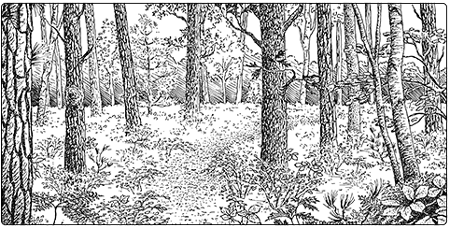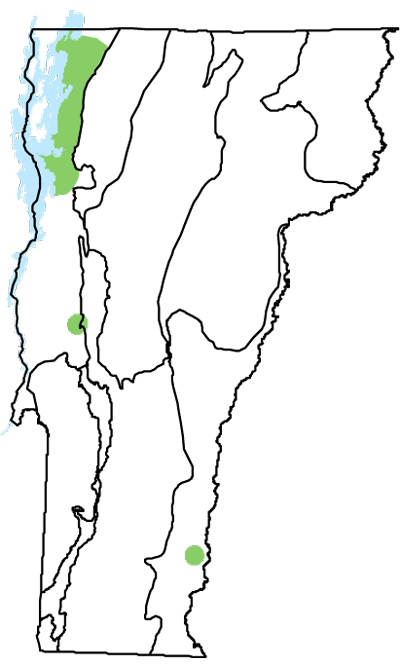Ecology and Physical Setting 
Dry Pine-Oak-Heath Sandplain Forest is one of Vermont’s rarest communities, and certainly one of its most threatened. Soils in this community are well-drained to excessively well-drained sands, varying locally in coarseness and moisture holding capacity. They are acidic and nutrient-poor. Underlying bedrock is buried so deeply by the sand that it has no influence on vegetation. The Champlain Valley sands were deposited postglacially, as large, sediment-filled rivers of glacial meltwater emptied into Glacial Lake Vermont or, later, into the Champlain Sea. Where the rivers entered the lake or sea, coarse sediments were deposited first, in great fan-shaped deltas. These deltas form our present-day sandplains, primarily near the mouths of the Winooski, Lamoille, and Missisquoi Rivers. Similar events took place in the Connecticut Valley, though on a smaller scale.
The sandplain ecosystem is an intriguing mosaic. Prior to European settlement, the flat, well-drained areas supported large expanses of Dry Pine-Oak-Heath Sandplain Forest that covered many thousands of acres. Within the fragments of these forests that remain on this generally level landscape, small variations in soils and topography result in notable changes in vegetation. Locally low areas, even on the tops of the deltas, can be quite moist or even wet, supporting wetland forests, vernal pools, or small open wetlands. On a larger scale, these sandplains are incised by streams, creating complex areas of flat terrain cut by deep gullies. The slopes of the gullies are slightly moister than the generally dry tops and often support Mesic Pine-Oak Sandplain Forest. At the bases of the gullies, underlying clay is often revealed. These dense soils hold water and support wetland natural communities. Occasionally, underlying calcareous bedrock is exposed and supports rich-site herbs. These small wetlands and moist gullies are exceptions, though; the heart of the sandplain is the flats above.
 Like the larger pine barrens of Albany, New York, and Concord, New Hampshire, these forests are fire-adapted communities. Ours, however, probably never had extensive open areas with stunted trees and parched windblown sand, as pine barrens have. The presence of pitch pine, a fire-adapted tree, suggests that fire has long played an important role in these forests; Siccama (1973) found that a pitch pine-oak forest occupied the sandplains at the time of the earliest land surveys of the 18th century. The frequency and extent of fires remains a mystery, though. While the history of fire in southern New England pine forests has been studied, the scientific literature presents no clear picture of the role of fire in Vermont’s sandplains prior to European settlement.
Like the larger pine barrens of Albany, New York, and Concord, New Hampshire, these forests are fire-adapted communities. Ours, however, probably never had extensive open areas with stunted trees and parched windblown sand, as pine barrens have. The presence of pitch pine, a fire-adapted tree, suggests that fire has long played an important role in these forests; Siccama (1973) found that a pitch pine-oak forest occupied the sandplains at the time of the earliest land surveys of the 18th century. The frequency and extent of fires remains a mystery, though. While the history of fire in southern New England pine forests has been studied, the scientific literature presents no clear picture of the role of fire in Vermont’s sandplains prior to European settlement.
Pitch pine’s bark protects the trees from light fires that can kill other species. In the southern part of its range, pitch pine needs fire to open its cones and disperse seeds. But here, in the northern part of its range, warm and dry conditions will cause the cones to open, so seeds can be dispersed without fire. The seeds germinate most successfully in the bare mineral soil that is left after a fire burns away the leaf litter. Historically, other plants probably benefited from fire, too. A number of the rare and uncommon plants of this community require open, dry areas that would be common where fires were frequent.
Vegetation
The canopy in these forests is fairly open. Pitch pine, white pine, red oak, and black oak are the most common canopy species. The relative abundance of pitch pine versus white pine at a given site may reflect fire history. Red maple can be abundant but is susceptible to fire. Tall shrubs are scattered. The ground layer is often very sparse, composed of low herbs and scattered low shrubs, most of them members of the heath family. Heaths, as a group, are especially well adapted to acidic conditions. Overall plant diversity is low, although Dry Pine-Oak-Heath Sandplain Forests have a disproportionately high number of rare species. Many of these species are at their northern range limits in Vermont and are more common elsewhere. The warm climate and sunny openings of our sandplains provide good habitat for them.
Wildlife Habitat
Although this is a fragmented community, it nevertheless offers important wildlife habitat. Gray squirrels thrive on the abundant acorns, and breeding birds include eastern wood pewees and pine warblers. Two invertebrates that may be found in Dry Pine-Oak-Heath Sandplain Forests have specific plant associations, but we have much more to learn about other invertebrates. The Carolina andrena bee specializes in the pollen from heath family plants, such as blueberries and huckleberries. A macropis bee (Macropis nuda) specializes in the pollen of the loosestrife genus (Lysimachia), and whorled loosestrife is a characteristic plant of these dry forests.
Successional Trends

When fire and other disturbances are absent from this community for a time, the duff layer will build up. Under these conditions, pitch pine seeds are inhibited from germinating while other species germinate and persist. Thus pitch pine is likely to decrease in importance, the canopy is likely to become more closed, and white pine, red oak, black oak, and red maple are likely to become more abundant. Over time, this could lead to a transition to a Mesic Pine-Oak Sandplain Forest. The many rare plants that rely on openings are likely to decrease in number as well, but viable seeds remain in the soil for years, waiting for the next natural disturbance.
Related Communities
- Mesic Pine-Oak Sandplain Forest is very similar to Dry Pine-Oak-Heath Sandplain Forest but lacks the regular fire regime, either because its landscape setting is less prone to lightning strikes or because its soils are less dry. Trees therefore grow taller and form a more closed canopy, and openings are less frequent. Pitch pine, usually indicative of fire history, is not found in Mesic Pine-Oak Sandplain Forest.
Conservation Status and Management Considerations
Pine-Oak-Heath Sandplain Forest is a very threatened community in Vermont. With their deep, well-drained soils, areas occupied by this community are in great demand for residential and industrial development, as well as for sand extraction. Of the original acreage in Chittenden County prior to European settlement—estimated at 15,000 acres based on the presence of suitable soils—we now have only about 1,000 acres, or about 6.7 percent of the original total. Much of the rest has been converted to housing developments, airports, commercial areas, graveyards, and agricultural fields. Conversion and loss of sandplain forests continues today. One very small example of this natural community is in a town park, and another much larger example is under excellent ecological management, including the use of prescribed fire. No large example has permanent legal protection.
Owners of good examples of this natural community can help maintain them by allowing natural ecological processes to function and by encouraging the growth of pitch pine and other species that are native to the community. Long-term restoration of sandplain forests, and their connections to other natural communities, is needed to sustain ecological processes into the future.
Distribution/Abundance
In Vermont, this community is restricted to sands in the warmer biophysical regions: the Champlain Valley and the Southern Vermont Piedmont. The most significant areas of Pine-Oak-Heath Sandplain Forest are in western Chittenden County, on the state’s largest sand deposits, but other sites are found in Franklin and Addison counties, and the southern Connecticut River valley.
Characteristic Plants
Trees
Abundant Species
Pitch pine – Pinus rigida
White pine – Pinus strobus
Black oak – Quercus velutina
Red oak – Quercus rubra
White oak – Quercus alba
Red maple – Acer rubrum
Occasional to Locally Abundant Species
Paper birch – Betula papyrifera
Gray birch – Betula populifolia
American beech – Fagus grandifolia
Red pine – Pinus resinosa
Shrubs
Abundant Species
Low sweet blueberry – Vaccinium angustifolium
Late low blueberry – Vaccinium pallidum
Black huckleberry – Gaylussacia baccata
Witch hazel – Hamamelis virginiana
Smooth shadbush – Amelanchier laevis
Beaked hazelnut – Corylus cornuta
Sheep laurel – Kalmia angustifolia
Sweet fern – Comptonia peregrina
Herbs
Abundant Species
Canada mayflower – Maianthemum canadense
Sarsaparilla – Aralia nudicaulis
Bracken fern – Pteridium aquilinum
Wintergreen – Gaultheria procumbens
Occasional to Locally Abundant Species
Starflower – Lysimachia borealis
Whorled loosestrife – Lysimachia quadrifolia
Pink lady’s slipper – Cypripedium acaule
Bastard toadflax – Comandra umbellata
Cow-wheat – Melampyrum lineare
Pipsissewa – Chimaphila umbellata
Rare and Uncommon Plants
Yellow panic grass – Dichanthelium xanthophysum
Blunt-leaved milkweed – Asclepias amplexicaulis
Hairy lettuce – Lactuca hirsuta
Plains frostweed – Crocanthemum bicknellii
Houghton’s cyperus – Cyperus houghtonii
Low bindweed – Calystegia spithamaea
Canada frostweed – Crocanthemum canadense
Harsh sunflower – Helianthus strumosus
Wild lupine – Lupinus perennis
Slender mountain-rice – Piptatheropsis pungens
Hay sedge – Carex siccata
Muhlenberg’s sedge – Carex muehlenbergii var. muehlenbergii
Large whorled pogonia – Isotria verticillata
Sweet goldenrod – Solidago odora
Long-spiked three-awn – Aristida longespica
Yellow wild-indigo – Baptisia tinctoria
Silver-flowered sedge – Carex argyrantha
Fernald’s sedge – Carex merritt-fernaldii
Wild sensitive plant – Chamaecrista nictitans
Lace lovegrass – Eragrostis capillaris
Racemed milkwort – Polygala polygama
Whorled milkwort – Polygala verticillata
Slender knotweed – Polygonum tenue
Scarlet oak – Quercus coccinea
Wood lily – Lilium philadelphicum
Blunt-lobed grapefern – Botrychium oneidense
Hairy bush-clover – Lespedeza hirta ssp. hirta
Tuckerman’s witchgrass – Panicum tuckermanii
Susquehanna sand cherry – Prunus susquehanae
Associated Animals
Eastern gray squirrel – Sciurus carolinensis
Eastern wood pewee – Contopus virens
Pine warbler – Dendroica pinus
Carolina andrena bee – Andrena carolina
Macropis bee – Macropis nuda
Rare and Uncommon Animals
Northern barrens tiger beetle – Cicindela patruela
Places to Visit
Sunny Hollow Natural Area, Colchester, Town of Colchester
Bellows Falls Union High School Forest, Westminster
